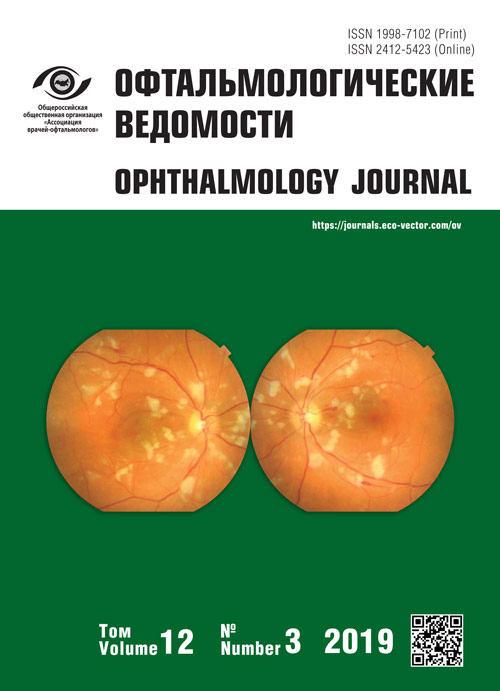肌切除术治疗上睑下垂的新方案:术式和结果
- 作者: Potyomkin V.V.1,2, Goltsman E.V.3
-
隶属关系:
- Pavlov First Saint Petersburg State Medical University
- City Multi-Field Hospital No. 2
- City Ophthalmologic Center of City hospital N 2
- 期: 卷 12, 编号 3 (2019)
- 页面: 83-90
- 栏目: In ophthalmology practitioners
- ##submission.dateSubmitted##: 15.09.2019
- ##submission.dateAccepted##: 27.09.2019
- ##submission.datePublished##: 16.12.2019
- URL: https://journals.eco-vector.com/ov/article/view/16049
- DOI: https://doi.org/10.17816/OV16049
- ID: 16049
如何引用文章
详细
背景 经结膜入路上睑下垂矫正手术,操作简单,预期效果好,因而广受欢迎。长期以来,去氧肾上腺素试验一直是影响选择上睑下垂矫正术式的主要因素。越来越多的研究表明Müller肌切除术也可适用于去氧肾上腺素试验阴性的患者。本研究提出并详述了一种经过改良的新型Müller肌切除技术,可帮助出现各种去氧肾上腺素试验结果的患者进行上睑下垂矫正。
材料和方法 本研究包括两组轻度至中度上睑下垂患者,上睑提肌肌力不低于8mm。实验组(75例患者,103个眼睑)接受了经过改良的Müller肌切除术,对照组(26例患者,35个眼睑)接受了“开放天空”Müller肌切除术。根据以下流程对实验组制定手术计划。去氧肾上腺素试验呈阳性及反应充分的患者,切除三分之二的Mülle肌。去氧肾上腺素试验呈阳性但反应不够充分的患者,行Mülle肌次全切除术。去氧肾上腺素试验呈阴性或弱阳性的患者,术中增加评估白线活动距离。如果白线的活动距离(单位mm)与下垂程度相当,行Mülle肌次全切除术保留上睑板。如果白线的活动距离低于预期矫正程度,同时行Mülle肌次全切除术与睑板切除术,以达到预期矫正程度,同时睑板剩余高度不得低于5mm。如果上睑板受损或无法达到上睑板预期切除程度,便将白线前移位固定至睑板处。
结果下垂程度、手术结果以及睑裂在中心、角膜外侧缘和角膜内侧缘的宽度、MRD 1和MRD 2无显著组间差异(p > 0.05),实验组矫正不足及矫正过度的频率显著降低(p < 0.05)。
结论 本研究提出的改良Mülle肌切除术是一种新的治疗流程,使去氧肾上腺素试验为弱阳性及阴性的上睑下垂患者可通过经结膜方法接受矫正,减少了矫正不足和矫正过度。
全文:
引言
尽管存在多种上睑下垂矫正方法,但手术始终是眼外科和整形外科的重要治疗手段。在众多的上睑下垂的手术治疗方法中,有三种值得关注:额肌瓣、经结膜Mülle肌(STM)切除术和经皮肤上睑提肌腱膜修复术 [1–5]。本文主要讨论经结膜的STM切除术。
既往STM切除术的主要适应症为轻度至中度上睑下垂,且上睑提肌(LPS)功能良好或无异常,且去氧肾上腺素(PE)试验呈阳性 [1, 4, 6, 7]。目前越来越多的研究人员指出,可对PE试验呈阴性(“–”)或弱阳性(“+/–”)患者实施改良的STM切除术 [8–11]。
STM切除量尤为重要。目前有很多计算方案。作为STM切除方案的创始人之一,Putterman认为,为达到通过10%PE滴注实现眼睑上提,应切除8.5mm STM,若每矫正不足或矫正过度0.5mm应增加或减少1mm STM的切除量,以使STM切除范围在6.5–9.5mm内。Weinstein的研究表明,需行8mm 的STM切除使上睑下垂矫正程度达到2mm,并推测矫正程度与切除量的比率为1:4 [13]。Dresner提出,切除4mm STM以矫正1mm上睑下垂,切除6mm以矫正1.5mm上睑下垂,切除8mm以矫正2mm上睑下垂,切除11-12mm以矫正≥3mm上睑下垂;如果PE试验反应不充分,应再切除睑板 [14]。Mercandetti等人研究得出结论,STM切除量与预期矫正程度的比率为3:1 [15]。Perry等人提出切除9mm STM,以达到和10%PE试验相同的眼睑高度;矫正不足时,另以1:1的比率切除睑板,但不应超过3mm,避免上睑不稳 [16]。目前STM切除方法尚无统一标准,因此开发新方法具有重要意义。此外,课题组前期研究中确定上睑下垂患者STM的长度为8至23mm不等。因此,在不考虑患者STM的初始长度的情况下,精确到毫米的照搬已有的STM切除方案并不可取。
材料和方法
本研究患者上睑下垂程度不同,且LPS功能尚佳或良好(不低于8mm)。排除标准为肌源性或神经源性上睑下垂、创伤性上睑下垂或有该病手术史,LPS功能不高于7mm,患有重度干眼综合征。
实验组为2017年11月至2019年8月由市第二综合医院第五显微眼外科收治住院的患者。共计75例(103个眼睑):男35例(46.7%),女40例(53.3%)。实验组患者平均年龄为54.8 ± 12.8岁。值得注意的是,实验组包括对PE试验结果不同的患者。75例患者的PE试验结果显示,37例(50个眼睑)为阳性(“+”)反应,38例(53个眼睑)为阴性(“–”)或弱阳性(“+/–”)反应。实验组患者通过本研究提出的改良STM切除术矫正上睑下垂。
对照组为2016年1月至2017年9月由市第二综合医院第五显微眼外科收治住院的患者。共计26例(35个眼睑):男10例(38.5%),女16例(61.5%)。平均年龄为54.9 ± 14.9岁。该组所有患者的PE试验结果均为“+”(表1)。回顾性分析了该组进行的上睑下垂矫正手术。患者根据Lake等人提出的方法实施了标准“开放天空”STM切除术,描述如下。
表1组内患者性别和年龄分布
指标 | 实验组 | 对照组 | “性别”指标的一般显著性(р) | |
性别 | 男 | 46,7 % (35) | 38,5 % (10) | 0,15 |
女 | 53,3 % (40) | 61,5 % (16) | 0,15 | |
年龄 |
| 54,8 ± 12,8 | 54,9 ± 14,9 | 0,51 |
选取上睑下垂手术治疗的主要评估参数,包括下垂程度、上睑上提程度以及睑裂在中心、角膜外侧缘和角膜内侧缘的宽度、MRD 1和MRD 2。MRD1(边缘反射距离)是第一眼位央角膜光反射和上眼睑边缘之间的距离 第一眼位上睑缘中央到角膜反射点的距离,MRD2是第一眼位下睑缘到角膜中心反射点的距离。
不同组之间的主要手术步骤相同,差异主要在于切除量计算方案,现述如下。
皮肤无菌处理,睫状缘上睑中部作一牵引缝线(vicryl 4.00)(图1a),借助眼睑拉钩(Desmarres)翻转上眼睑(图1b)。从睑板上缘处划开结膜,分离STM(图1c),分离白线(图1d;仅实验组)。PE试验反应为“–”或“+/–”的患者在STM肌腹中央作牵引,来评估活动性(图1e;仅实验组)。将STM同睑板缝合固定(图1f),切除STM(图1g)。用U形缝线(vicryl 6.0)将STM剩余部分固定于睑板缘(图1e)。连续缝合将结膜与睑板固定(图1h,i)。
图1 Mülle肌(STM)切除术的主要步骤(文中所述)
改良Mülle肌切除术切除量的计算方案
图2显示了改良STM切除量的计算方案,详述如下(专利申请号2019127580, 2019年08月30日):
图2 改良Mülle肌(STM)切除术方案
PE试验结果为“+”且充分的患者切除STM的三分之二,对PE试验结果为“+”但不充分的患者,行STM次全切。PE试验结果为“–”和“+/–”的患者,在手术过程中另外评估了白线的活动距离。如果白线的活动距离(单位mm)符合预期(上睑上提完全消除下垂),行STM次全切术,保留上睑板。如果白线的活动距离低于预期,联用STM次全切术与睑板切除术,补足差值,前提是睑板的剩余高度至少为5mm。如果高度未达到要求而导致无法行睑板切除术,则联用STM次全切除术及上睑提肌腱膜徙前术。如果白线无活动距离,根据下垂程度切除LPS腱膜或将白线向睑板移位。
标准“开放天空”Mülle肌切除术切除量计算方案(对照组)
值得注意的是,所有接受了STM切除术的患者,PE试验结果均为“+”。对于PE试验结果为“+”且充分的患者,行STM次全切除术或联合睑板切除术,根据预期确定切除量。
通过Microsoft Excel 2010和统计软件IBM SPSS Statistics 23(IBM公司)对研究结果进行统计分析。描述定量变量时,详述指标均值和标准差。Shapiro-Wilk检验正态性。Van der Waerden检验两组定量变量比值,如果p值<0.05,则认为差异具有统计显著性。
结果
改良STM切除术效果的主要评估参数有上睑下垂程度、上睑上提程度以及睑裂在中心、角膜外侧缘和角膜内侧缘的宽度、MRD 1和MRD 2。在术前及术后3个月后对上述所有参数进行评估。回顾性分析对照组上睑下垂手术矫正结果。对比分析实验组和对照组的上睑下垂矫正手术结果。
对实验组进行术后后期功能结果评估。在术前及术后3个月后对所有指标进行分析。结果见表2.
表2 实验组改良STM切除术结果(Van der Waerden检验)
指标 | 术前 | 术后3个月后 | 显著性(р) |
下垂程度 | 3,4 ± 0,9 | 0,09 ± 0,3 | <0,0001 |
中心睑裂的宽度 | 5,6 ± 0,9 | 8,9 ± 0,4 | <0,0001 |
角膜外侧缘睑裂的宽度 | 4,2 ± 0,9 | 7,7 ± 0,6 | <0,0001 |
角膜内侧缘睑裂的宽度 | 3,1 ± 0,8 | 6,6 ± 0,6 | <0,0001 |
MRD1 | 0,6 ± 0,9 | 3,9 ± 0,4 | <0,0001 |
MRD2 | 4,8 ± 0,4 | 5 | 0,17 |
STM,Mülle肌;MRD1,上睑缘中央到角膜反射点的距离;MRD2,下睑缘中央到角膜反射点的距离。 | |||
本研究表明,对于PE试验结果不同的上睑下垂患者而言,倘若LPS功能尚佳或良好,改良STM切除术是一种行之有效的矫正方法。两组组间比较结果相似,指标无显著性差异(表3)。
表3 组间比较分析结果
指标 | 改良STM切除术 | 标准STM切除术 | 显著性(р) |
下垂程度 | 0,09 ± 0,3 | 0,12 ± 0,8 | 0,12 |
中心睑裂的宽度 | 8,9 ± 0,4 | 8,8 ± 0,8 | 0,2 |
角膜外侧缘睑裂的宽度 | 7,7 ± 0,6 | 7,7 ± 0,8 | 0,88 |
角膜内侧缘睑裂的宽度 | 6,6 ± 0,6 | 6,6 ± 0,7 | 0,89 |
MRD1 | 3,9 ± 0,4 | 3,8 ± 0,9 | 0,2 |
MRD2 | 5 | 5 | 1 |
结果 | 2,6 ± 0,8 | 2,0 ± 0,6 | 0,035 |
STM,Mülle肌;MRD1,上睑缘中央到角膜反射点的距离;MRD2,下睑缘中央到角膜反射点的距离。 | |||
除了上述指标,我们还对比了两组矫正不足和矫正过度出现的频率,发现对照组矫正不足及矫正过度出现的频率显著偏高(表4)。我们认为这是在制定手术治疗计划时,切除量计算错误所致。
表4 组内矫正不足和矫正过度出现频率
指标 | 改良STM切除术 | 标准STM切除术 | 显著性(р) |
矫正不足 | 6.8%(7个眼睑) | 17.1%(6个眼睑) | 0.0001 |
矫正过度 | 0.97%(1个眼睑) | 5.7%(2个眼睑) | 0.0001 |
STM,Mülle肌。 | |||
讨论和结论
1961年,经结膜的上睑下垂矫正技术开始受到关注,并有研究人员首次发表了STM切除的文献 [5]。1975年,Putterman和Urist介绍了一种新型改良STM切除术,其核心包括STM及结膜的分离切除和保留睑板 [7]。长期以来,人们认为STM切除仅仅是LPS腱膜切除的一种方法。但组织学研究结果表明,被切除组织主要是STM和结膜 [5]。经结膜技术的主要优势在于操作简单和结果预测好。
迄今为止的文献研究表明,STM切除术不适用于PE试验结果为“–”和“+/–”的患者 [1, 4, 6, 7]。然而,越来越多的报道显示,PE试验结果为“+/–”和“–”的患者接受STM切除术后效果良好。我们认为,应该扩大STM切除术的适应症范围, 并且PE试验或许不是选择手术矫正术式时的唯一决定因素。
因改良的STM切除术可能适用于PE试验结果为“–”和“+/–”的患者,故使用本研究提出的上述方法不仅能够扩大STM切除术的适应症范围,而且能够计算所需的切除量。此外,通过这种方法能够确定在尽可能保留睑板的情况下睑板的切除量。
该技术的主要特点是白线活动距离的评估。白线为独立结构,是LPS横纹肌和STM平滑肌之间的过渡区域。对于PE试验结果为“–”和“+/–”的患者,白线活动距离评估是制定改良STM切除术方案不可或缺的一步。
基于上述内容,我们提出的改良STM切除术主要适应症为:
- 轻度至中度先天性和获得性腱膜性上睑下垂,LPS功能不低于8mm;
- PE试验反应为“+”、“–”和“+/–”。
综上所述,针对肌源性或神经源性获得性的上睑下垂改良STM切除术的可行性研究还在继续。目前,该项技术已成功运用于两例霍纳综合征患者。然而,仍有必要在更大样本患者中研究这一改良STM切除术的效果以扩大其适应症范围。
作者简介
Vitaly Potyomkin
Pavlov First Saint Petersburg State Medical University; City Multi-Field Hospital No. 2
Email: ageeva_elena@inbox.ru
PhD, Assistant Professor. Department of Ophthalmology
俄罗斯联邦, 197089, St. Petersburg, Lev Tolstoy str., 6-8, building 16; 194354, St. Petersburg, Uchebniy pereulok, 5Elena Goltsman
City Ophthalmologic Center of City hospital N 2
编辑信件的主要联系方式.
Email: ageeva_elena@inbox.ru
ophthalmologist
俄罗斯联邦, 194354, St. Petersburg, Uchebniy pereulok, 5参考
- Ben Simon GJ, Lee S, Schwarcz RM, et al. External levator advancement vs Müller’s muscle-conjunctival resection for correction of upper eyelid involutional ptosis. Am J Ophthalmol. 2005;140(3):426-432. https://doi.org/10.1016/j.ajo.2005. 03.033.
- Blaskovics L. Treatment for ptosis: formation of a fold in the eyelid and resection of the levator and tarsus. Arch Ophthalmol. 1929;1(6):672-680. https://doi.org/10.1001/archopht. 1929.00810010698002.
- Custer PL. Ptosis: levator muscle surgery and frontalis suspension. In: Chen WP, eds. Oculoplastic surgery: the essentials. New York: Thieme; 2001. P. 89-100.
- Finsterer J. Ptosis: causes, presentation, and management. Aesthetic Plast Surg. 2003;27(3):193-204. https://doi.org/10.1007/s00266-003-0127-5.
- Fox SA. Surgery of ptosis. Archives of Ophthalmology. 1980; 98(1):186. https://doi.org/10.1001/archopht.1980.01020030188025.
- Ben Simon GJ, Lee S, Schwarcz RM, et al. Müller’s muscle-conjunctival resection for correction of upper eyelid ptosis: relationship between phenylephrine testing and the amount of tissue resected with final eyelid position. Arch Facial Plast Surg. 2007;9(6): 413-417. https://doi.org/10.1001/archfaci.9.6.413.
- Putterman AM, Urist MJ. Müller muscle-conjunctiva resection. Technique for treatment of blepharoptosis. Arch Ophthalmol. 1975;93(8):619-623. https://doi.org/10.1001/archopht.1975.01010020595007.
- Baldwin HC, Bhagey J, Khooshabeh R. Open sky Müller muscle-conjunctival resection in phenylephrine test-negative blepharoptosis patients. Ophthalmic Plast Reconstr Surg. 2005;21(4):276-280. https://doi.org/10.1097/01.iop.0000167789.39570.3e.
- Lake S, Mohammad-Ali FH, Khooshabeh R. Open sky Müller’s muscle-conjunctiva resection for ptosis surgery. Eye (Lond). 2003;17(9):1008-1012. https://doi.org/10.1038/sj.eye.6700623.
- Peter NM, Khooshabeh R. Open-sky isolated subtotal Müller’s muscle resection for ptosis surgery: a review of over 300 cases and assessment of long-term outcome. Eye (Lond). 2013;27(4):519-524. https://doi.org/10.1038/eye.2012.303.
- Malhotra R, Patel V. Transconjunctival blepharoptosis surgery: a review of posterior approach ptosis surgery and posterior approach white-line advancement. Open Ophthalmol J. 2010;4(1): 81-84. https://doi.org/10.2174/1874364101004010081.
- Putterman AM, Fett DR. Müller’s muscle in the treatment of upper eyelid ptosis: a ten-year study. Ophthalmic Surg. 1986;17(6): 354-360.
- Weinstein GS, Buerger GF Jr. Modification of the Müller’s muscle-conjunctival resection operation for blepharoptosis. Am J Ophthalmol. 1982;93(5):647-651. https://doi.org/10. 1016/s0002-9394(14)77383-0.
- Dresner SC. Further modifications of the Müller’s muscle-conjunctival resection procedure for blepharoptosis. Ophthalmic Plast Reconstr Surg. 1991;7(2):114-122. https://doi.org/10.1097/00002341-199106000-00005.
- Mercandetti M, Putterman AM, Cohen ME, et al. Internal levator advancement by Müller’s muscle-conjunctival resection: technique and review. Arch Facial Plast Surg. 2001;3(2):104-110. https://doi.org/10.1001/archfaci.3.2.104.
- Perry JD, Kadakia A, Foster JA. A new algorithm for ptosis repair using conjunctival Müllerectomy with or without tarsectomy. Ophthalmic Plast Reconstr Surg. 2002;18(6):426-429. https://doi.org/10.1097/00002341-200211000-00007.
补充文件









